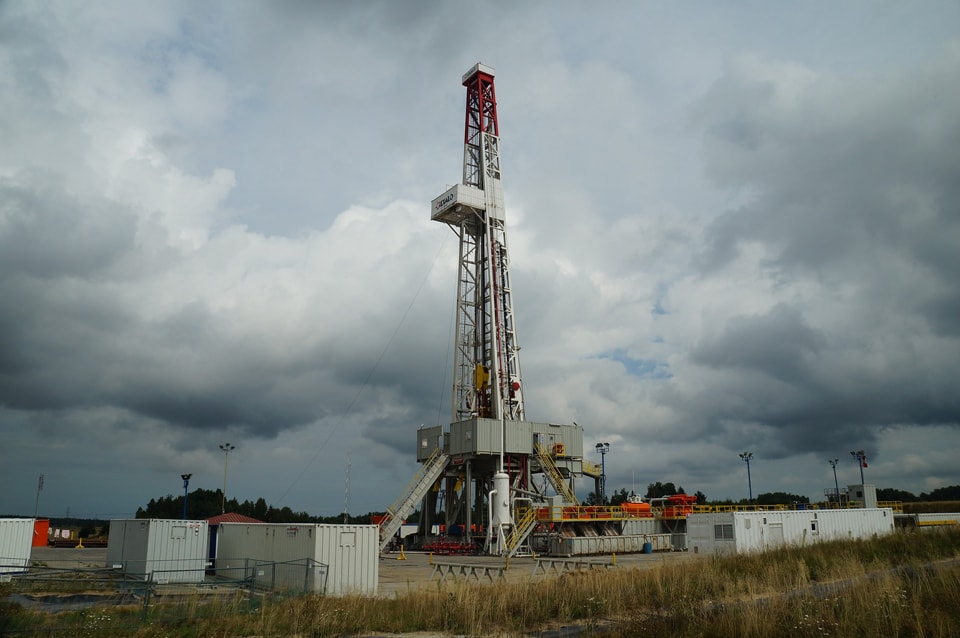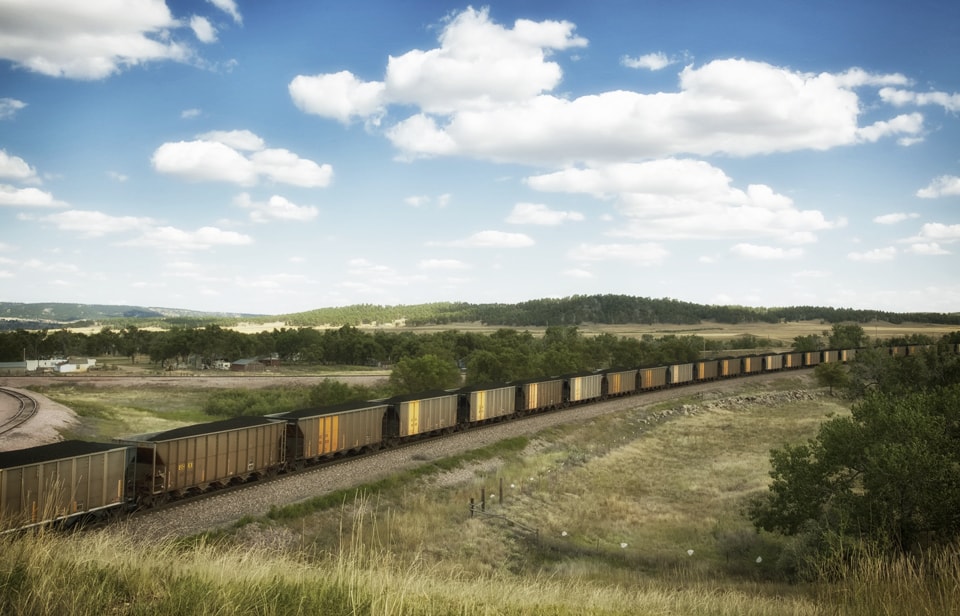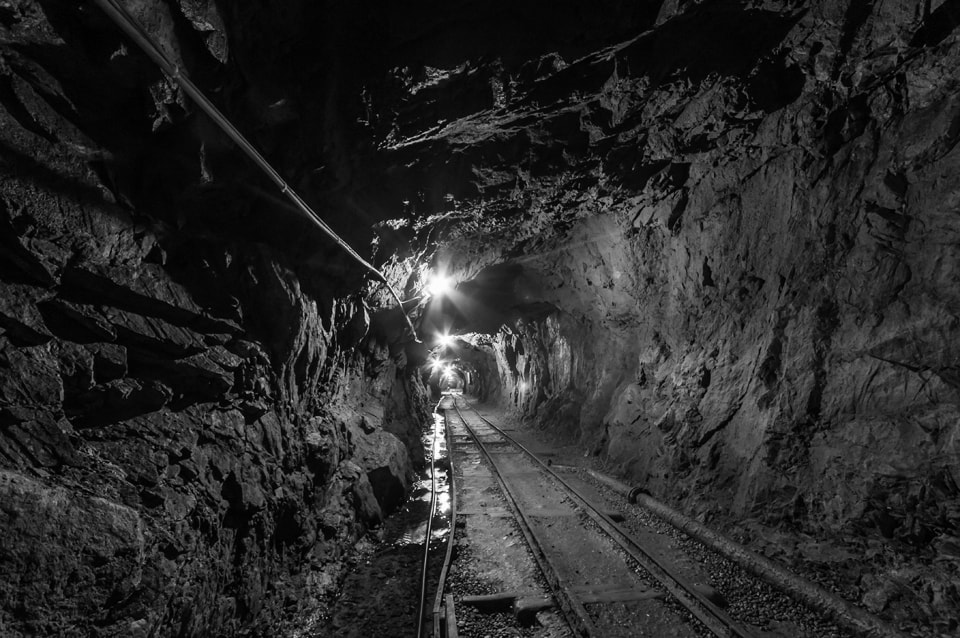Eighty-one percent of the world’s primary energy supply is derived from oil, coal, or natural gas. Four-fifths of the energy we use — for the industry, heating, and transport — comes from holes in the ground. From these holes issues forth 9,800 million tonnes of oil equivalent each year [1]. Extraction is a primal pursuit, a business of wresting raw materials from the earth that can be converted into value. From pits, wells, and mines, raw geology is liquidated into energy and money, a double-alchemy at the heart of the modern capitalist economy. The car, the fridge, and the lightbulb — technological embodiments of modernity’s power to diminish distance, forestall the seasons, and render irrelevant the earth’s rotation – remain for the most part tethered to a netherworld of rocks and reservoirs.
Landscapes of energy extraction are portals, wormholes between two worlds in which time and space work differently. Underground lies a world of “natural production;” the deep-time processes beyond human control that create the hydrocarbon concentrations we know as fossil fuels. Because the conditions under which hydrocarbons form and collect are not found everywhere, the quality of underground space is highly variable: the highest-quality concentrations provide massive ecological subsidies to modern economic and social life. Aboveground and freed from geological fixity, energy is thrown into a tumultuous world of “social production;’ a surface world of mobility and change where “the quality of space, as well as that of time, is…asymptomatically reduced to zero…the ‘annihilation of space by time”‘ [2]. If the distribution of fossil energies underground served to differentiate time and space — Carboniferous/Jurassic/Cretaceous; deep/shallow reserves, giant/supergiant fields — their distribution on the surface strives “to overcome all the obstacles that make (space) distinguishable:” Once out through the hole and dispersed across the planet via trade, concentrated stocks of energy that were assembled below ground over millions of years are shattered into highly distributed, low-order forms of energy through countless moments of combustion. The hole is both a space of ecological appropriation in which those with social power lay claim to naturally produced materials and a conduit through which these materials are employed in the transformation of space and nature [3].
The social critic Lewis Mumford made much of the mine and the alien spaces of the hole. Technics and Civilization (1934) reveals his captivation by the radically different environments experienced on crossing the threshold to the underground. It was written on the eve of one of the most significant energy transitions of the twentieth century: the shift, in North America and then in Europe and Japan, from coal to oil as the most important source of industrial energy. Although Mumford enthuses over the coming of a “neotechnic” era of light metals and hydroelectricity, he largely overlooks the tremendously generative capacities of petroleum for it is coal — and carboniferous capitalism — that provide his primary point of reference. Deeply impressed by the simulacra of a coal mine in the basement of the Deutsches Museum in Munich, Mumford passionately describes a profoundly unfamiliar world that was not only “inorganic” but also “inedible;” a world where value lay in the abstract and the speculative rather than in the potential for direct sustenance. The acts of digging and drilling — and the materialities of the hole as a space of labor — encapsulated the hopes and anxieties of the machine age whose factories, ships, and weaponry they fed. Extractive landscapes may represented “a triumph of human ingenuity and fortitude over the fickle reluctance of nature,” but Mumford also recognized how “the act of wresting minerals from the earth has historically required the subjugation and demeaning of both nature and humankind, as faceless pairs of hands and unseen laboring backs descend into the dark, inhuman hell of tunnels to strip away the organs of nature.”
We might quarrel on technical grounds with Mumford’s use of “inorganic” or quibble over the way he down plays the energetic capacities of fossil fuels, but his recognition of the mine/hole as an archetypal space of modernity seems spot on: “mine, blast, dump, crush, extract, exhaust;” wrote Mumford, are the “syntax of modernity.” Historians of technology have expanded Mumford’s analysis by thinking about the ways in which the logics and spaces of extraction inform urbanization: technologies of surveying, lifting, and construction pioneered in mining become imported into the city; the rationalities of ecological simplification and radical abstraction that underpin geological science become a hallmark of urban design; and the dominance of “artificial means” epitomized by the mine come to characterize the experience of urban life. Gray Brechin, for example, provides a compelling account of the environmental history of San Francisco, which grew to prominence in the California Gold Rush and subsequently financed the silver mines of the Comstock Lode, the gold mines of South Dakota, and the copper mines of Montana [4]. The cycling of mineral wealth through the city, and its fixation in urban space, leads Brechin to argue that the skyscrapers of San Francisco are technologically, economically, and philosophically the “inverted mines” of the city’s massive hinterland: natural wealth excavated from the depth and piled up on the surface. Today the fantasy skylines of Houston or Dubai achieve a similar inversion: their thrusting towers and sprawling infrastructure embody the three-dimensional geographies of oil and gas fields in the Gulf of Mexico and the Middle East from which their wealth and power derives.
Extractive Spaces 1: Geographies of Holes
An oil well or mine shaft represents a discrete, molecular point of access rather than a contiguous territorial claim. It is a vertiginous point in space, rather than a laminar, extensive presence. As a commercial enterprise, extraction rests on monopolizing control over a few strategic spaces that provide access to mineral-rich portions of the underground. Contrast this with the expansive geographies of forestry or agriculture, where production and the generation of value are diffused across a broad surface. The restricted portals that characterize extraction channel these fossil energy resources into highly concentrated ribbons. Because of the way they concentrate flow into a confined space (and therefore afford tremendous potential for control) oil wells and coal mines are vertical analogues of the chokepoints and bottlenecks conventionally associated with oil shipment. The punctuated, discontinuous geographies of extraction do not coincide well with notions of national territory or development. Conventional political maps of global oil production — which assign annual production among individual states — are misleading in this regard, because they portray oil emerging from the space of the state like a fitted carpet: uniformly, and right up to the walls. That discontinuous character of extractive spaces has at least four consequences.
First, the “molecular” nature of extraction means that a principal axis of competition is the struggle to locate the right point of access and secure exclusive control over it, rather than to expand a territorial domain. The “concession” is the classic spatial form of property around which this struggle takes place: an exclusive right of access to resources beneath the surface, the concession makes possible processes of primitive accumulation while leaving intact the state’s broader claims to territorial sovereignty. Although the colonial concession has evolved, exclusive and geographically specific rights of access to sovereign mineral resources remain the norm. Extractive energy landscapes are characterized by discrete spatial monopolies — patchworks of mining claims and oil concessions that codify a logic of holding ground and “securing the hole,” in which power comes not from the ability to control specific patches of ground. Those who live and work in an oil patch know well how — culturally, economically, and politically de facto — land ceases to be part of national space and becomes instead a series of miniature corporate states: a modern mirror of feudal fiefdoms, with the corporate concession holder as sovereign.

Second, the piecemeal and discontinuous spatiality of extractive landscapes confounds efforts to harness resource extraction to desires for national development. Extraction produces classic enclave economies that are, at the same moment, both deeply integrated into the global economy and fragmented from national space [5]. It is not that extraction fails to produce development, but that it produces scales of community and governable spaces that rarely conform to the imagined space of the “nation;” as Michael Watts’s work on the contradictions of communities formed in and around oil in Nigeria neatly demonstrates [6]. If, for Mumford, mining was the quintessence of modernity, for many geographers and anthropologists it is the partiality and incompleteness of the modernity wrought by extraction that is striking. The peculiar spatialities of extraction are among the reasons that it remains a uniquely difficult form of development, a phenomenon popularly described (but not explained) by the notion of a “resource curse.” Indeed, the classical enclave economies’ of colonial resource extraction have become a metaphor for the fractured, spatially uneven forms of economic and social transformation associated with globalization [7].
Third, although individually wells and shafts are discrete and separate, maps of drilling activity reveal how holes cluster in space. Over time, chronological sequences of drilling produce geographical traces that provide a material record of the economic and political conditions in which they were made, and the corporate and national strategies they were designed to further. At the global scale, broadly similar petroliferous regions are peppered with oil and gas wells in strikingly uneven ways. For example, although its oil reserves are far smaller than those of Saudi Arabia, Iran, Canada, or Venezuela, the United States is by far the most intensively drilled country on earth: by the 1980s nearly 3 million exploration and development wells had been sunk for oil, reflecting national conditions of competitive capitalism and policies firmly supporting a domestic oil sector [8].
Fourth, all the holes and mineral extraction in aggregate still account for a very small proportion — less than 1 percent — of the terrestrial land surface. The environmental politics of extraction, then, are less about the cumulative extent of extraction or its impact on large sections of the world’s population. Instead, efforts to renegotiate the social license to extract oil, gas, and coal center on the specific location of new energy landscapes. A high proportion of the world’s remaining oil and gas reserves are located in parts of the world that increasingly are valued for their biodiversity and/or wilderness. In addition, the implications of extraction on the livelihood strategies of people living in and around areas newly valued for their energy resources are of increasing concern. The simple equation of natural-resource-based development that “oil extraction = wealth generation” is now recognized as a highly contingent outcome: far more common is the phenomenon of the “cobbler without shoes” in which local communities are excluded not only from the wealth that resource extraction can create but also from the utility of the resource itself: in parts of Siberia, for example, local people heat their homes with peat and wood as natural gas, encased in gleaming pipes, streams right by their door.
Extractive Spaces 2: The Hole Is Only the Half of It
The hole is an essential feature of the extractive landscape, but the hole is just the start. The point where fossil energy resources exit the ground is where most accounts of the energy commodity chain begin: coal, oil, and gas channeled into a surface world of transportation, differentiation, and proliferation. By moving materials horizontally across space, diverse use-values of fossil fuels are realized and profits generated from exchange. Getting oil, coal, and gas to travel — producing forms and infrastructures that enable energy resources to be exchanged across space — is far from trivial and has required the creative energies of science, technology, finance, and law. Not only are fossil fuels flammable, highly variable in quality, and expensive to store, they are also heavy and/or bulky and therefore require a good deal of energy to mobilize them in the direction of markets. Coal, in particular, has a low value-to-volume ratio, and coal’s energy grade per unit weight is significantly less than for oil or gas. Thus, coal has tended not to move long distances, [9] and major markets for coal — such as iron, steel, and metal smelting — were often located at the mouths of mines (i.e., near coal fields). Today, however, coal moves over remarkable distances: in the Pacific, coal leaves export terminals in Indonesia and Australia for power stations and steel mills in South Korea, India, and Japan; in the Atlantic, coal from South Africa, Canada, Colombia, and Russia enters European ports.
Extended geographies of energy trade are an outcome of a struggle between scale economies in production and scale economies in transportation, a struggle that is responsible for producing new frontiers of extraction [10]. To overcome the cost of distance via greater economies of scale, revolutionary changes in shipping technologies and handling terminals are developed: in oil, for example, the very large crude carrier (capacity up to 320,000 deadweight ton (dwt)) and ultra large crude carrier (up to 550,000 dwt) developed in the 1960s and 1970s respectively. Yet servicing these larger-capacity transportation units and terminals also required the development of mines and oil wells capable of sufficient capacity. Bigger ships and pipelines, in other words, require bigger holes to feed them. The result is a simultaneous process of emergence and abandonment: large energy deposits once considered too distant from markets become connected via investments in transportation that reduce the unit costs of moving energy, and marginal producers are pushed to the wall. Over time, the rhizomatic structures that direct the flow of fossil fuels have become stretched across distance so that economies of investment and trade in oil, coal, and gas now assume a global character.
Extractive Spaces 3: The Others of Production
But it is not only energy resources that are dragged from the point of extraction. Energy does not emerge from the hole in a pure, unencumbered form but is accompanied by materials from which it must be separated. Entrained in the 97 kilotons of energy flowing from the earth each year is a stream of waste products. These hidden flows are integral to the process of extraction and are mobilized along with the energy resource but nonetheless must find places of disposal. Mining and quarrying are estimated to move more than 57 billion tons per year worldwide: that’s ten times as much as glaciers and a little more than the amount moved by water erosion each year. Not for nothing do some critics of mining frame it as a waste disposal rather than resource acquisition business. The extraction of energy, then, involves not only the appropriation and liquidation of the underground and its channeling to distant markets but also the terraforming of a whole landscape as large volumes of material are sorted and separated into flows with dramatically different social valences. On the one hand is the energy resource characterized by high positive social valence and geographical ambition, which rapidly travels far from the point of extraction and circulates widely in the world of social production. On the other hand are the wastes that have negative social valence and are dumped around the hole. The result is the classic residual architecture of extractive landscapes — spoil heaps, waste ponds, slag piles, tank farms, tramways, stacks, and flues clustered around the hole — a landscape of sorting, dispatch, and abandonment that materializes abstract calculations of value.
In the Hole, a Whole World
In landscapes of energy, one finds expressed the logics and spirit of capitalist modernity. Although energy landscapes are not reducible to the space of the hole, the practices that characterize the point of fossil energy extraction vividly illustrate how wealth and power can be derived from the control and appropriation of natural resources. I conclude with three summary observations about the spaces of the hole. First, through mines and oil and gas wells, societies gain access to stores of energy that have accumulated over millions of years. The space of the hole effectively compresses time as, for example, the “rotating drill pushes in an instant from one millennium to the next as it cuts through the sedimentary rocks of the Pliocene, the Cretaceous, the Triassic” [11]. The result is that reserves of energy formed unimaginably slowly underground gush to the surface, the rate of release far exceeding the rate of formation. These immensely concentrated flows represent geological subsidies to the present day, a transfer of geological space and time that has underpinned the compression of time and space in modernity.
Second, drawing fossil energies from the earth remains a visceral process whose hard labor and brute reality continues to shock: the fire on the Piper Alpha platform in the North Sea in 1988 or the nine coal miners reported (in official statistics) to die every day in China serve to remind us that the holes through which energy flows are among the most dangerous working environments on earth [12]. Extractive landscapes are human spaces and the business of extraction requires the (temporary) habitation of the underground and its portals as much as it does the removal of energy resources. Because it is the labor of those who work in extractive spaces that mobilizes flows of energy, mines, oil fields, and other spaces of extraction are often strategic sites for challenging the social relations of capitalism.
Finally, the environmental history of holes — the episodic, discontinuous expansion of drilling and digging activity over larger and larger areas — highlights a geographically expansionary dynamic at the heart of capitalism. Today oil and gas development in the Arctic and the tropics are among the most striking — and problematic — features of the contemporary global economy, as they raise challenging questions about the social value of fossil fuels and the impacts of energy development on cultural and biological diversity. The creation of new energy landscapes and the abandonment of traditional sites are two sides of the same process, an insatiable drive toward the end of the earth that has seen the extractive frontier constantly redefined.
A version of this article was originally published in New Geographies 02: Landscapes of Energy.
 Gavin Bridge is Professor of Economic Geography at Durham University in the United Kingdom, and has research expertise in the political economy and governance of natural resources. His research centres on the spatial and temporal dynamics of extractive industries – oil, gas and mining – and has been supported by the US National Science Foundation, European Commission, UK Energy Research Centre, UK Economic and Social Research Council, British Academy, and the National Geographic Society. Gavin is co-author of Oil (Polity Press, 2013), co-editor of the Handbook of Political Ecology (Routledge, 2015), and Editor of Transactions of the Institute of British Geographers. He is co-founder and former Chair of the Energy Geographies Working Group of the Royal Geographical Society-Institute of British Geographers, and a member of the Editorial Boards of Political Geography, Mineral Economics and Geoforum.
Gavin Bridge is Professor of Economic Geography at Durham University in the United Kingdom, and has research expertise in the political economy and governance of natural resources. His research centres on the spatial and temporal dynamics of extractive industries – oil, gas and mining – and has been supported by the US National Science Foundation, European Commission, UK Energy Research Centre, UK Economic and Social Research Council, British Academy, and the National Geographic Society. Gavin is co-author of Oil (Polity Press, 2013), co-editor of the Handbook of Political Ecology (Routledge, 2015), and Editor of Transactions of the Institute of British Geographers. He is co-founder and former Chair of the Energy Geographies Working Group of the Royal Geographical Society-Institute of British Geographers, and a member of the Editorial Boards of Political Geography, Mineral Economics and Geoforum.
Notes
[1] International Energy Agency, Key World Energy Statistics (Paris: IEA, 2008). The figures of 81 percent and 9,800 million tonnes are calculated from figures for World Total Primary Energy Supply as published by the IEA. The dominant role of coal, oil, and gas can also be calculated from figures for World Energy Consumption. Data in the BP Statistical Review of World Energy (2009), for example, suggest an even greater dominance of fossil energies: 88 percent and 9,956 million tonnes of oil equivalent.
[2] Elmar Altvater, The Future of the Market An Essay on the Regulation of Money and Nature (London, New York: Verso, 1993).
[3] Stephen Bunker, “Natural Values and the Physical Inevitability of Uneven Development under Capitalism,” in Rethinking Environmental History: World System History and Global Environmental Change, edited by Alf Hornborg, John McNeill, and Juan Martinez-Alier (Lanham, MD: AltaMira Press, 2007), 239-258.
[4] Gray Brechin, Imperial San Francisco: Urban Power, Earthly Ruin (Berkeley: University of California Press, 1999).
[5] Mazen Labban, Space, Oil and Capital (London, New York: Routledge, 2008).
[6] Michael Watts, “Antinomies of Community: Some thoughts on Geography, Resources, and Empire,” Transactions of the Institute of British Geographers 29(2), 2004: 195-216.
[7] James Ferguson, Global Shadows: Africa in the Neoliberal World Order (Durham: Duke University Press, 2006); James Sidaway, “Enclave Space: A New Metageography of Development?” Area 39(3), 2007: 331-339.
[8] Judith Rees, Natural Resources: Allocation, Economics and Policy (London, New York: Routledge, 1991).
[9] The coal bunkering trade is an exception, as the strategic nature of coal for shipping enabled this bulk commodity to selectively move over greater distances.
[10] Stephen Bunker and Paul Ciccantell, Globalization and the Race for Resources (Baltimore: Johns Hopkins Press, 2005).
[11] ltalo Calvino, “The Petrol Pump,” in Numbers in the Dark and Other Stories (New York: Pantheon Books, 1995).
[12] James Fallows, “Correction: Chinese Coal Mine Deaths,” Atlantic, 18 March 2009. http:/ijamesfallows.theatlantic.com/archives/
2009/03/correction_chinese_coal_mine_d.php



